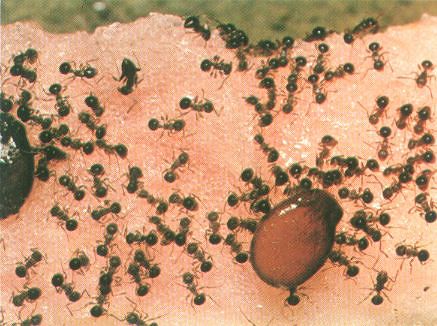| Spiders
| Bats | Snakes
| Ants | Cockroaches
| Leeches | Rats
& Mice
Phylum, Arthropoda; Class,
Insecta; Order, Hymenoptera
Identifying Features
Appearance (Morphology)
| The body of an ant is
clearly divided into three sections: the head, the thorax, and the gaster.
(The narrow waist is actually within the abdomen, so the part of the abdomen
behind the waist is called the gaster.) The waist can be made up of one
or two small segments, depending on the species. |
|
|

Camponotus (Camponotus)
japonicus Mayr
Ants are social insects
living in colonies comprised of one or a few queens, and many workers.
The queen generally stays deep and safe within a nest. Most ants that you
see are workers and these are all females. Depending on species, workers
may be similar in size, or come in a range of sizes.
Ants tend to come in dark
or earth tones. Different species are black, earth-tone reds, pale tans,
and basic browns.
Caveat: Ants are very diverse
and it is difficult to generalize about them. Therefore, if ants you collect
don't quite fit these generalizations, consult such books as The Ants (Hölldobler
and Wilson) and/or local experts.
Adult Males and Females
When ant colonies reproduce,
the new queens and males may be found in the colony. These are "flying
ants" and have two pairs of wings. Males generally have small heads, large
eyes, large thoraces, and a pair of claspers at the end of the gaster.
Once they fly (and mate), males do not live very long. After mating, new
queens break off their wings and never fly again. Without wings, they can
generally be distinguished from workers by their larger body size, larger
thorax and larger abdomen. All workers are females.
Immatures (different stages)
Ant larvae are white and grub
like. They have no legs and don't move about much on their own. You can
generally see a large, dark stomach through their cuticle. Ant pupae look
like white adult ants, with their legs and antennae pressed close to their
bodies.In some species, larvae spin silk and the pupal stage is inside
a cocoon. Newly emerged adult ants are often paler than older ones. It
may take them several days to reach their final color. |
|
|
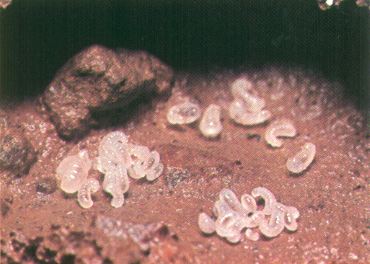
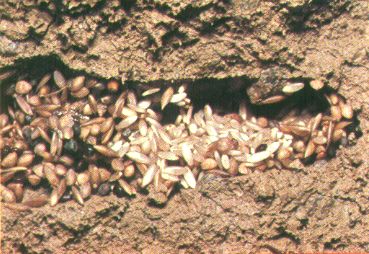
Larvae
chamber; Food stock-piling chamber.
The
seed coat has been peeled away.
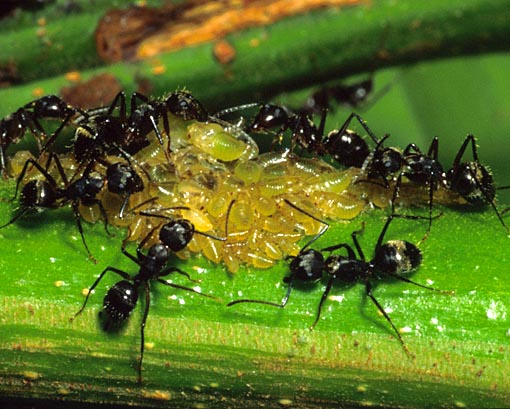
| These Ecuadorian ants
are harvesting the sweet honeydew secretions of larval treehoppers in return
for protection against other insect predators. In this arrangement, ant,
larva and adult treehoppers all existed in harmony. Some ants actually
corral and rear aphids for the purpose of cultivating their honeydew supplies.
The biblical food known as mana that fed the Israelites as they trekked
through the Sinai Desert was probably a honeydew secretion. |
|
|

The
aphid, or ant's cow. secreet sweet sap favored by the ants; the
ants
carry them to the buds of trees that produce a large amount of sweet sap.
|

A swarm
of Oligomyrmex yamatonis ants The smallest ant in Japan
Natural History
Food
Most ants that are easy to
keep in the classroom are generalists, eating a variety of small insects
that they capture, dead insects they happen to find, nectar, or honey dew.
They need a balance of carbohydrates and protein. Protein is especially
needed for the queen to make eggs and for the larvae to grow.
Habitat
Most ant species live in the
soil. Some, like the carpenter ants, also live in wood (they excavate,
but do not actually eat the wood). Some ants live in cavities made inside
plants, such as acorns, twigs, and galls.
Predators
A variety of reptiles or amphibians
(particularly toads and lizards), spiders, other insects such as assassin
bugs, and other ants may prey on workers. Bats, birds, and occasionally,
people capture and kill or eat the flying males and females.
Interesting Behaviors
Since ants are social they
display many behaviors that remind us of our families and society. For
example, worker ants take care of larvae by feeding and washing them. Ants
are able to communicate with each other. They are able to communicate,
among other things, directions (to where the food is) and alarm.
Impact on the Ecosystem
Positive
World wide, ants are one of
the most important predators on small invertebrates, including other insects.
Leafcutting ants in the American tropics are the most important herbivores
(plant consumers), outranking grazing mammals. In many ecosystems, ants
are important dispersers of the seeds that they harvest. In desert regions,
they are one of the principle consumers of seeds. Wherever ants live, they
turn over and aerate the soil as much or more than earthworms (depending
on the specific ecosystem). (For more information, see Hölldobler and
Wilson's book).
Negative
A few ant species are considered
pests, because they live in and protect territory that we consider ours
or because they want to consume resources that we need. For example, leafcutting
ants (see "Positive" section above) compete with us for crop plants in
the American tropics. Fire ants colonize damp grasslands (including lawns!)
with alarming ease. Carpenter ants, adapted for living in dead wood, consider
the dead wood (lumber) in houses fair game, especially if it is damp. A
number of opportunistic ant species can overrun kitchens, pantries, and
pet food areas in search of suitable food items. Also, some ants (like
their relatives the wasps and bees) have a potent sting. As with bees,
some people can become hypersensitive to ant stings. |
|
|
|
 |
The ant lion sucks up the body
fluid of an ant after dragging the ant down to the bottom
of the predator's trap into
which the ant has fallen.
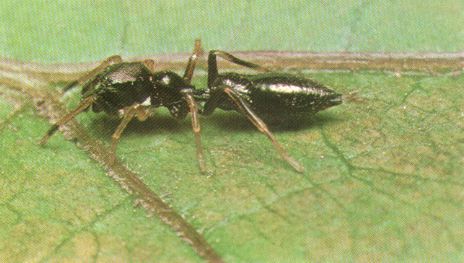
A jumping spider projecting
the forelegs like antennae
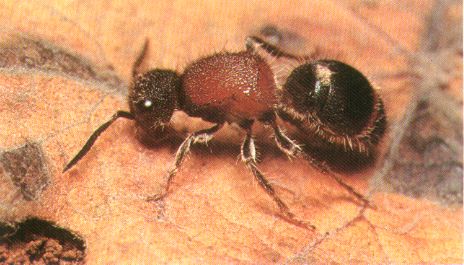
A velvet ant
| Collecting Live Insects
Where to find
Ants are found under logs,
particularly rotting logs that pull apart easily. In some parts of the
U.S., ants live in acorns or twigs on the ground. Catch new queens near
porch lights in warm months. If you are lucky, you may see new queens before
they have found a place to dig. Worker ants and vertical dirt ant farms
can be purchased from: Carolina Biological Supply Company, WardÍs Biology,
Connecticut Valley Biological Supply Co., Inc., Nasco Science, Science
Kit and Boreal Laboratories. Some states (AZ, HI and TN) have restrictions
to importing different species of ants and require you to apply for a USDA
permit.
How to collect
By gently turning over rocks
on warm spring days you may find a colony with the queen and brood. Since
the light and air will disturb the ants, work quickly to gather the queen
and as much brood as possible before they go underground. Use an aspirator
or small shovel to remove the ants and brood from the colony. If you use
a shovel to dig, take care when placing the dirt and ants into a container
with light oil or Vaseline around the rim so that the ants can't escape.
Let the dirt dry out slowly. Place the test tubes with water and cotton
plugs in the box on top of the soil. As the soil dries out, the ants will
move into the tubes. When most of the ants are in the tubes, transfer them
to a dirtless nest. (Place an incandescent light over the container to
make the ants move faster). |
|
|
|
